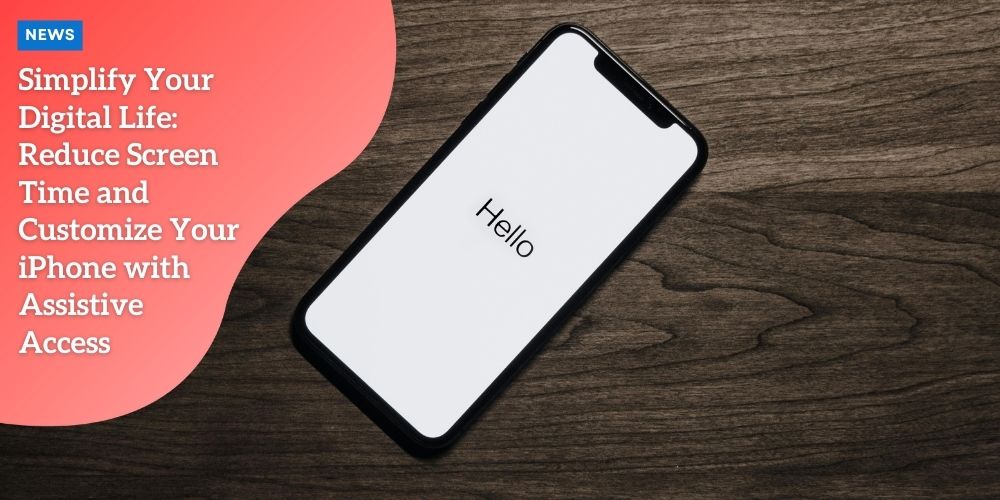Simplify Your Digital Life: Reduce Screen Time and Customize Your iPhone with Assistive Access
By: marcus Posted in: April 9, 2024 Last Update: April 29, 2024

Introduction to Assistive Access
In this digital era, technology intertwines with our daily lives, offering boundless opportunities. However, for some users, the intricacies of modern devices can be overwhelming. Enter Assistive Access, a beacon of simplicity amidst the digital chaos. But what exactly is Assistive Access, and how does it simplify the digital experience for users?
Anúncios
What is Assistive Access and its Purpose?
Assistive Access, an innovative feature by Apple, is tailored to streamline the interface of iPhones and iPads, particularly beneficial for those with cognitive disabilities. Nevertheless, its advantages extend beyond this demographic. It simplifies the user experience by offering a basic device setup that minimizes distractions and complexity. The aim is to provide a personalized digital experience, allowing users to select essential apps while excluding potential “time wasters.” Noted digital minimalism advocate Briones underscores the importance of stepping away from distractions, suggesting that this mode could facilitate better self-control.
Functionality of Assistive Access on iOS 17 Devices
Activating Assistive Access on iOS 17 devices is a straightforward process. By navigating to Settings and then Accessibility, users can access this feature to begin customization. Once activated, it transforms the device into a simpler version with a custom home screen displaying selected apps. These include essential Apple apps like Calls, Camera, Messages, Music, and Photos, along with others chosen for privacy. Personalization options extend to layout, battery visibility, Siri access, and volume controls, all aimed at providing a more individualized experience. Additionally, users can set a passcode to secure the mode, preventing unauthorized exit or tampering.
To reduce screen time and enhance focus, Assistive Access offers both grid and list views for app arrangement. Notifications for apps not on the home screen can be disabled to avoid distractions, ensuring users remain within the Assistive Access environment unless they choose otherwise.
Anúncios
Significance of Assistive Access in Providing a Streamlined Interface
Assistive Access plays a crucial role in simplifying the smartphone interface, particularly for individuals with cognitive disabilities. By streamlining the interface to include only necessary features, it reduces mistakes and provides peace of mind for caregivers. Furthermore, it caters to various demographics, including children and seniors, offering a safer and more focused device usage experience. Whether transforming an iPhone into an emergency-only phone or a distraction-free tool for seniors, Assistive Access represents a significant advancement in customizable technology, meeting diverse user needs effectively.
As our digital world evolves, finding balance becomes essential. Assistive Access demonstrates technology’s ability to adapt to our needs, prioritizing accessibility and simplicity. It redefines device interaction, emphasizing that sometimes, less truly is more.
Setting Up Assistive Access
Embarking on the journey to simplify your digital experience with Assistive Access, setting up this feature on iOS 17 devices is simple. The curated selection of essential Apple apps tailored for this streamlined mode enhances the usage of your iPhone significantly.
Anúncios
Calls
The Calls app in Assistive Access mode merges the traditional Phone and FaceTime apps for ease of use. Making a call becomes a quick, accessible communication process, ensuring staying connected remains simple.
Camera
The Camera app retains its essential functions for capturing moments in Assistive Access mode. Simplified functions like photo snapping or video recording remove the complexity of filters or editing features, fostering a more present interaction with the device.
Messages
The Messages app in Assistive Access mode prioritizes clear viewing of conversations and simplifies typing responses. Here, messaging returns to its roots—exchanging words with clarity and purpose, free from distractions.
Music
The Music app within Assistive Access simplifies browsing your library or streaming service, prioritizing auditory pleasure over visual clutter. It transforms any iPhone into an oasis of sound, promoting relaxation or rejuvenation.
Photos
In Assistive Access mode, managing and viewing photos becomes effortless, emphasizing your pictures without complex editing tools.
Users can choose between a grid or list layout for these core apps, with customization options extending to battery level display, Siri activation, and volume button functionality. Managing notifications judiciously is advisable to maintain focus.
Enhanced Controls for Specific Demographics
In the digital age, providing a safe, accessible, and distraction-free environment for all users is essential. Assistive Access on iOS 17 devices offers just that—a customizable space where functionality meets individual needs. Let’s explore how Assistive Access benefits various demographics.
Assistive Access: A Boon for Children’s Digital Safety
Assistive Access serves as an enhanced parental control tool, aiding parents in crafting a child-friendly digital experience. By simplifying usage and allowing tighter limitations, it helps mitigate common challenges of children bypassing standard restrictions. Selecting approved contacts ensures communication is restricted to pre-approved individuals, enhancing digital safety for children and peace of mind for parents.
Empowering Seniors with Simplified Interaction
As technology evolves, seniors may find standard smartphone features overwhelming. Assistive Access simplifies interaction by paring down the interface to essentials, making calls, sending messages, or capturing memories less confusing. Larger icons and visual-based controls cater to those who struggle with small touch targets or intricate menus.
Creating a Less Distracting Smartphone Experience
Smartphones often draw users into a cycle of distraction, impacting productivity. Assistive Access offers a solution by trimming down apps and streamlining the interface, allowing users to focus on tasks without constant distractions. This minimalist setup can serve as a digital detox, promoting presence in daily activities.
Setting Up Assistive Access for Children
Setting up Assistive Access for a child’s iPhone involves:
- Updating the device to iOS 17.
- Navigating to Settings → Accessibility → Assistive Access.
- Selecting ‘Selected Contacts’ for calling and messaging to customize communication options.
- Educating the child on contacting emergency services without navigating through various apps.
By using Assistive Access, users tailor their digital experience to support unique needs. Whether setting up a senior-friendly interface or creating a kid-safe phone, Assistive Access provides a flexible and secure foundation for personalized digital interactions.
Conclusion
Assistive Access offers more than a simplified interface—it provides a pathway to digital minimalism. Exploring resources and communities dedicated to Assistive Access can offer continued support and inspiration for refining digital experiences. Joining online forums, seeking parental guidance resources, or engaging with senior tech support groups can enhance your journey towards a simpler digital life.
As you reflect on your progress in simplifying your digital life, embrace the simplicity and share your experiences with others. With Assistive Access, technology becomes a tool to enhance rather than encroach upon daily life. Join a community, explore resources, and continue refining your digital experience. Together, let’s foster a culture of mindful technology use.





